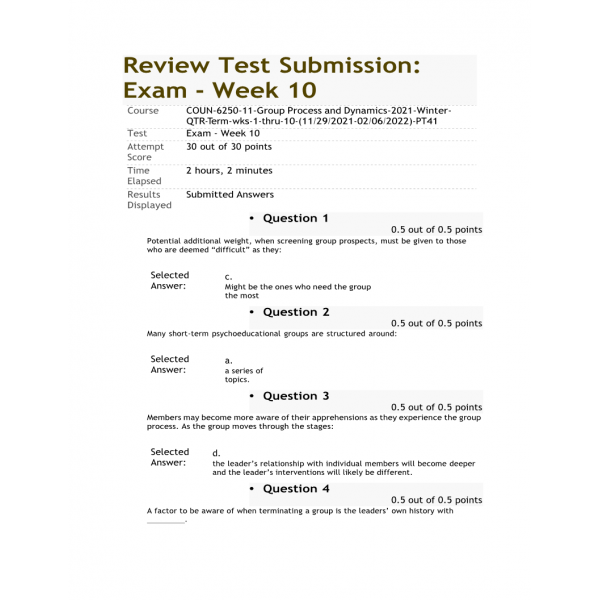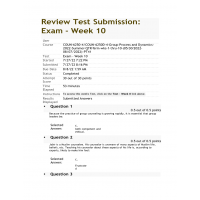COUN 6250-11 Week 10 Exam (Winter 2021 - 30 out of 30)
COUN-6250-11-Group Process and Dynamics-2021-Winter- QTR-Term-wks-1-thru-10
Exam - Week 10
30 out of 30 points
1. Potential additional weight, when screening group prospects, must be given to those who are deemed “difficult” as they:
2. Members may become more aware of their apprehensions as they experience the group process. As the group moves through the stages:
4. Which of the following is of paramount concern when screening and selecting potential group members?
5. The reactions members develop toward the group leader and other members can bring out intense feelings in those who are the target of their reactions.
6. Jabir is a Muslim counselee. His counselor is unaware of many aspects of Muslim life, beliefs, etc. Teaching his counselor about these aspects of his life is, according to experts, likely to make him feel:
8. Personal , by the leader, can be useful when it is intentional and keeps the focus of attention on the group members rather than on the leader.
9. As members approach the ending of a group or are leaving an ongoing group, it is equally essential that they be encouraged to express their reactions. They may have fears or concerns about .
11. The process of encourages members to accept responsibility for the outcomes of a group and for changing the style in which they relate to others.
13. Abundant research indicates the centrality of as a primary factor in successful therapy, and this is inextricably intertwined with the outcome of psychotherapy.
14. A competent therapist remains in the counseling process while maintaining openness about .
17. Mort works in a position of authority. He is a college guidance counselor. He is now a member of a court-mandated group. When others speak of their problems, he is always the first to react, even at the risk of cutting off other would-be responders. He seems to speak more than any other member. His behaviors could legitimately be construed as:
19. Some participants may engage in , believing they are really working, when in fact they are avoiding addressing and dealing with their own feelings.
20. Leaders have a responsibility to discuss any breaches with the group and to take action
21. Isabella continually refers to “Kyle” in what often proves to be lengthy tangents regarding her college years. The name itself evokes a high degree of passion. The group leader can/should:
22. A behavior in which a group counselor addresses issues by setting an example of himself or herself is known as:
25. The major task is to provide the and the challenge necessary for members to face and resolve conflicts and negative reactions that exist within the group and certain
26. The importance of the is a well-established critical component of effective therapy.
27. Which of the following is a characteristic of a working group?
28. The operate to differing degrees in all stages of a group, but they are most often manifested during the working stage.
30. Each member must actively work to open him- or herself to others and to addressing the issues that get in the way of doing so.
31. A healing capacity develops within the group as members increasingly experience of who they are.
32. Which of the following is NOT considered a critical-to-address characteristic of the Transition Stage?
33. Before groups progress to a level of deeper work, which we refer to as the working stage, they typically experience a:
34. When forming a proposal for a group, which of the five general guideline areas would you ask yourself the question: does your proposal contain strategies for evaluating how well the stated objectives were met?
36. One way for members to share their experience with others outside the group without breaking confidentiality or informed consent is:
37. Which of the following is a clear sign that trust is being built within the group?
38. are characterized by changing membership. As certain members leave, new members are admitted, and the group continues.
40. A counselor meets with a client who is wearing the traditional garb associated with a particular religious group.
41. The counselor holds a negative view of this group’s beliefs in
42. While group members are sharing extremely personal information, leaders can remind members about as a way of reassuring the member who is disclosing.
43. Starting a session with a brief can set the group up to involve as many members as possible in productive work for that session.
44. Some members may lack understanding or experience in participating in groups, and their struggle to learn new behavior patterns should not be labeled as .
45. Because the practice of group counseling is growing rapidly, it is essential that group leaders be:
46. The setting and reinforcement of clearly spelled-out group norms is a recommended way of ensuring group .
47. focus on developing members’ cognitive, affective, and behavioral skills through a structured set of procedures within and across group meetings.
48. Leaders should avoid until they have earned that right by building a trusting relationship with the members.
50. The done prior to beginning a group helps us learn the history of group members, which enables us to better understand some of their reactions during the
51. Alan and Arturo, members of a counseling group, have expressed similar feelings of inadequacy following divorce.
52. Sensing this, the leader attempts to foster a line of communication regarding the commonality of the issue between these members.
53. This attempt to build cohesiveness and interaction is known as:
54. As members successfully interact with one another in the Working Stage, the leader can expect less to be directed toward himself or herself.
| Institution & Term/Date | |
| Term/Date | Walden University |
-
$14.99


